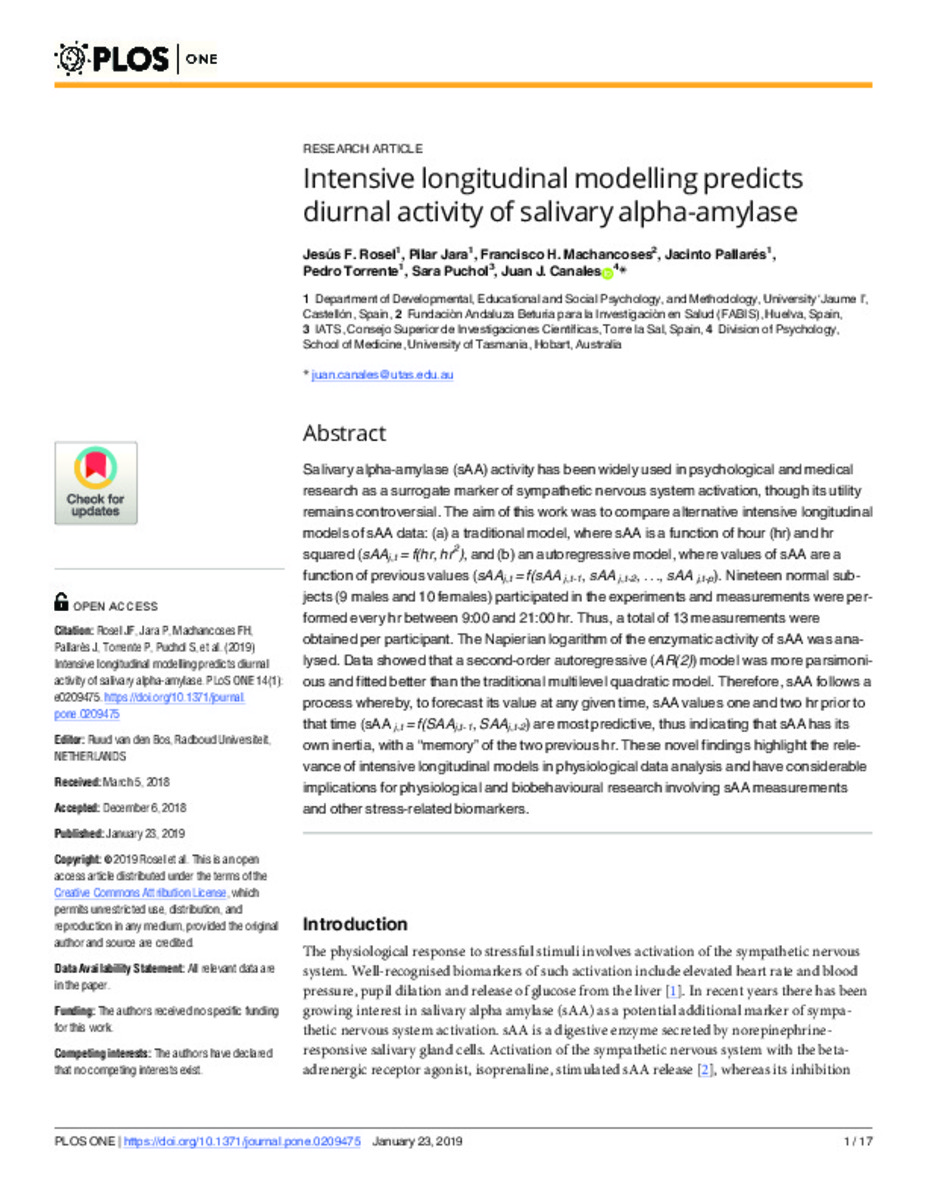Mostrar el registro sencillo del ítem
Intensive longitudinal modelling predicts diurnal activity of salivary alpha-amylase
| dc.contributor.author | Rosel, Jesús F. | |
| dc.contributor.author | Jara Jiménez, Pilar | |
| dc.contributor.author | Machancoses, Francisco H. | |
| dc.contributor.author | Pallarés, Jacinto | |
| dc.contributor.author | Torrente, Pedro | |
| dc.contributor.author | Puchol, Sara | |
| dc.contributor.author | Canales, Juan J. | |
| dc.date.accessioned | 2019-03-11T16:33:54Z | |
| dc.date.available | 2019-03-11T16:33:54Z | |
| dc.date.issued | 2019 | |
| dc.identifier.citation | Rosel JF, Jara P, Machancoses FH, Pallare´s J, Torrente P, Puchol S, et al. (2019) Intensive longitudinal modelling predicts diurnal activity of salivary alpha-amylase. PLoS ONE 14(1): e0209475. https://doi.org/10.1371/journal. pone.0209475 | ca_CA |
| dc.identifier.issn | 1932-6203 | |
| dc.identifier.uri | http://hdl.handle.net/10234/181815 | |
| dc.description.abstract | Salivary alpha-amylase (sAA) activity has been widely used in psychological and medical research as a surrogate marker of sympathetic nervous system activation, though its utility remains controversial. The aim of this work was to compare alternative intensive longitudinal models of sAA data: (a) a traditional model, where sAA is a function of hour (hr) and hr squared (sAAj,t = f(hr, hr2 ), and (b) an autoregressive model, where values of sAA are a function of previous values (sAAj,t = f(sAA j,t-1, sAA j,t-2, . . ., sAA j,t-p). Nineteen normal subjects (9 males and 10 females) participated in the experiments and measurements were performed every hr between 9:00 and 21:00 hr. Thus, a total of 13 measurements were obtained per participant. The Napierian logarithm of the enzymatic activity of sAA was analysed. Data showed that a second-order autoregressive (AR(2)) model was more parsimonious and fitted better than the traditional multilevel quadratic model. Therefore, sAA follows a process whereby, to forecast its value at any given time, sAA values one and two hr prior to that time (sAA j,t = f(SAAj,t-1, SAAj,t-2) are most predictive, thus indicating that sAA has its own inertia, with a “memory” of the two previous hr. These novel findings highlight the relevance of intensive longitudinal models in physiological data analysis and have considerable implications for physiological and biobehavioural research involving sAA measurements and other stress-related biomarkers. | ca_CA |
| dc.format.extent | 17 p. | ca_CA |
| dc.format.mimetype | application/pdf | ca_CA |
| dc.language.iso | eng | ca_CA |
| dc.publisher | Public Library of Science | ca_CA |
| dc.relation.isPartOf | PLoS ONE 14(1) 2019 | ca_CA |
| dc.rights | © 2019 Rosel et al. This is an open access article distributed under the terms of the Creative Commons Attribution License, which permits unrestricted use, distribution, and reproduction in any medium, provided the original author and source are credited. | ca_CA |
| dc.rights | Atribución 4.0 Internacional | * |
| dc.rights.uri | http://creativecommons.org/licenses/by-sa/4.0/ | * |
| dc.title | Intensive longitudinal modelling predicts diurnal activity of salivary alpha-amylase | ca_CA |
| dc.type | info:eu-repo/semantics/article | ca_CA |
| dc.identifier.doi | https://doi.org/10.1371/journal.pone.0209475 | |
| dc.rights.accessRights | info:eu-repo/semantics/openAccess | ca_CA |
| dc.relation.publisherVersion | https://journals.plos.org/plosone/article?id=10.1371/journal.pone.0209475 | ca_CA |
| dc.type.version | info:eu-repo/semantics/publishedVersion | ca_CA |
Ficheros en el ítem
Este ítem aparece en la(s) siguiente(s) colección(ones)
-
MED_Articles [642]
Articles de publicacions periòdiques -
PSI_Articles [594]
Articles de publicacions periòdiques
Excepto si se señala otra cosa, la licencia del ítem se describe como: © 2019 Rosel et al. This is an open
access article distributed under the terms of the
Creative Commons Attribution License, which
permits unrestricted use, distribution, and
reproduction in any medium, provided the original
author and source are credited.








